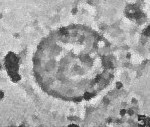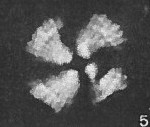Heliotrochus kleinpellii

Set number: 2331
-
1
-
2
-
3
-
4
-
5
-
6
-
7
-
8
-
9
-
10
-
11
-
12
-
13
-
14
-
15
-
16
10µm
Set number: 2330
-
1
-
2
-
3
-
4
-
5
-
6
-
7
-
8
-
9
-
10
-
11
-
12
10µm
Heliolithus kleinpellii Sullivan, 1964
Large to very large (9.0–18.0μm) circular species of Heliotrochus composed of two discs, a column and a central canal with a plug/tube cycle. Heliotrochus kleinpellii possesses two thin discs and a low column that exhibit similar height/thickness, which produces a compressed character in the species. The discs are of unequal diameter, as the width of the proximal disc is much greater than the width of the median disc. In the side-view, the compressed appearance of the discs and column illustrates the lack of mass distributed along the vertical (height) axis, causing the species to be consistently observed only in the plan-view.
In the cross-polarised light, the extinction lines are dextrogyre in the distal view/column side, whereas the extinction lines are laevogyre in the proximal view/disc side. When observed using a gypsum plate, the horizontal axis and blue region are correlated on the distal side, and the vertical axis and blue area are aligned on the proximal side. In plan-view, the birefringent discs and column appear striated and display yellowish-whiteish birefringence.
Heliotrochus and Bomolithus are differentiated based on column height (e.g. Heliotrochus possess a low column and thin discs of similar height/thickness, Bomolithus display a high column and discs of differing height/thickness). The double discs and low column of Heliotrochus kleinpellii are distinguishing features that separate it from the species of Heliolithus and Caycedoa. Moreover, Heliotrochus kleinpellii is further differentiated from Caycedoa by its birefringent discs observed in plan-view. Species of Tonromeinia also consist of two discs and a column. Still, their discs and a column are all of similar size (e.g., diameter and height), and they have a large opening dominating their central area. Heliotrochus kleinpellii demonstrates a distinct decrease in the diameter of the discs, whereas Heliotrochus steurbautii shows a gradual reduction in the diameter of the discs and column.
Aubry, M. -P. 2015. Cenozoic Coccolithophores: Discoasterales. Micropaleontology Press, American Museum of Natural History, New York. pp. 1-455.
Bowman, A. R. & Varol, O. 2021. A Taxonomic Revision of Heliolithaceae - Applications in Resolving the Problematic Calcareous Nannofossil Biostratigraphy of the Paleocene. In: M. Montenary, M. (Ed.). Calcareous nannofossil biostratigraphy of the Stratigraphy and timescales. 6: 43-223.
Sullivan, F. R., 1964. Lower Tertiary nannoplankton from the California Coast Ranges. I. Paleocene. University of California Publications in Geological Sciences 44, 163-227.

